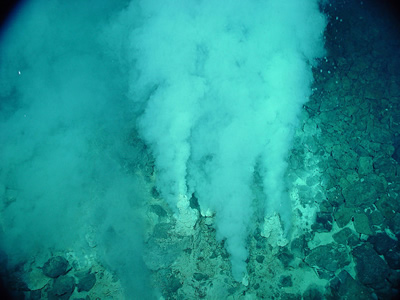The Earth's crust is made up of the continents and the ocean basins.
Oceanic crust, which consists of basaltic rock, is thinner and denser than continental crust, which contains granitic rock; because of this, the continents rise above the oceans.
On average, continents are about 0.5 miles (0.8 kilometers) above sea level, while the ocean floor is about 2.4 miles (3.8 kilometers) below sea level. While continental crust is about 22 miles (35 kilometers) thick, oceanic crust is only about 4 miles (7 kilometers) thick.
Hydrothermal Vent. Source: US National Oceanic and Atmospheric Association
The ocean basins contain many extraordinary geological features, including deep trenches and vast mountain ranges.

Continental Margins
A continental margin is a part of the ocean basin that is adjacent to a continent. It includes the continental shelf, a sloping section of material that lies on top of continental crust. If seawater recedes and continental crust is exposed, some of the continental shelf may become part of a coastal plain.
Beyond the continental shelf is a steep downward slope known as the continental slope. Sometimes, it leads to a gradual incline, with a slope usually of less than half a degree, which is known as the continental rise. This consists of sediment that piled up after traveling down the continental slope.
Deep Ocean Basins
Eventually, the continental shelf or continental rise leads to a deep ocean basin. Comprising 30 percent of the Earth's surface, the deep ocean basins contain flat abyssal plains, deep ocean trenches and submerged volcanoes known as seamounts.
Abyssal Plains
Abyssal plains are about 2.5 miles (4 kilometers) below sea level. They are made of volcanic rock that is covered with very thick layers of sediment. Over time, this sediment has spread out and flattened, making abyssal plains the flattest places on earth.
There is no light on an abyssal plain. The temperature averages around 36 degrees Fahrenheit (2 degrees Celsius), much colder than at sea level, and atmospheric pressure is hundreds of times higher. Because there is no sunlight, plants cannot live here. The animals here eat decaying organic matter that sinks to the bottom of the ocean.
Deep Ocean Trenches
Deep ocean trenches are depressions that form when tectonic plates collide, and one plate slides beneath the other, or subducts.
Some deep ocean trenches form when two oceanic plates meet. These run parallel to chains of volcanic islands, known as volcanic island arcs. The deepest oceanic trench on Earth, the Mariana Trench, which is found in the Pacific, east of the Philippines, was formed by the subduction of the Pacific Plate beneath the Philippine plate. Challenger Deep in the Mariana Trench is the deepest place on Earth. It is more than 36,000 feet (almost 11,000 meters) below sea level - almost one and one fourth times as deep as Mount Everest is tall.
Other oceanic trenches form near continents, when oceanic crust subducts beneath lighter continental crust. The Peru-Chile trench off South America's west coast formed this way, when the Nazca plate, made of oceanic crust, subducted beneath the South American plate. This trench lies parallel to the Andes Mountains.
Seamounts
Seamounts are underwater volcanoes. Unlike volcanic islands, they never rise above the ocean's surface. Scientists think there are about 100,000 seamounts at least one kilometer (more than half a mile) high.
Biological diversity is very high at seamounts, which are home to many different species of fish. Corals, sponges, marine mammals and other living things can also be found here. Many commercial fisheries operate at seamounts, and some scientists are worried that overfishing is causing ecological damage.
The Seamounts Marine Management Area, also known as Las Gemelas, is a protected area off the Pacific coast of Costa Rica. It is part of Cocos Island National Park, a UNESCO World Heritage site.
Mid-Ocean Ridges
A mid-ocean ridge is an underwater, volcanic mountain chain that forms when two tectonic plates pull away from each other, at a divergent boundary. As these plates separate, magma rises up the crust to fill up the space, resulting in seafloor spreading.
Together, all of the mid-ocean ridges form the mid-ocean ridge system, a continuous belt of volcanoes that circles the globe for more than 43,000 miles (70,000 kilometers), the longest mountain range on Earth.
At the East Pacific Rise, a mid-ocean ridge in the southeastern Pacific, the Pacific Plate is moving away from the Cocos, Nazca and Antarctic Plates at a rate of about 3 inches (7.5 meters ) a year, making the East Pacific Rise the Earth's fastest spreading mid-ocean ridge.
The Mid-Atlantic Ridge separates the North American and South American plates from the Eurasian and African plates. These plates are spreading apart at the rate of about 1 inch (2.5 centimeters) per year. Iceland and the Azores are part of the Mid-Atlantic Ridge.
Mid-ocean ridges contain hydrothermal vents, places where water that once percolated into the ocean crust rises up from the crust again after hot magma heats it. Because this water is under very high pressure, it does not boil, despite reaching temperatures of more than 700 degrees Fahrenheit (340 degrees Celsius).
Amazingly, creatures known as hyperthermophiles live in hydrothermal vents. They are able to survive in the extreme heat, living off the chemicals that form when seawater interacts with magma. Hyperthermophiles are extremophiles, organisms that live in extreme conditions that most living things on Earth could not survive. Astrobiologists study extremophiles to try to learn whether life could exist outside the Earth.